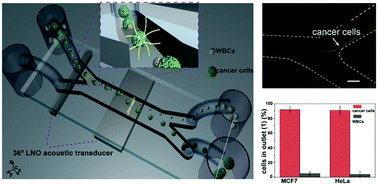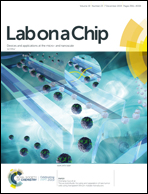The acoustofluidic focusing and separation of rare tumor cells using transparent lithium niobate transducers†
Abstract
Research on circulating tumor cells (CTCs) is of great significance in cancer diagnosis, prognosis and even the development of personalized therapy. Here, we present a simple and transparent acoustofluidic device for CTC separation in a label-free and non-invasive manner, instead of traditional acoustic devices based on silicon substrates, which are not only expensive, but also not conducive to optical visualization. The device is based on cheaper glass fabrication and integrated with a 36° Y-rotated cut lithium niobate single crystal (36° LNO) coated indium tin oxide (ITO) acoustic actuator instead of piezoceramics. It could greatly reduce the generation of heat when the signal is excited by utilizing the thickness vibration mode of the 36° LNO single crystal material because of its super-linear performance. Moreover, pre-aligning the particles in the sample inlet in a two-dimensional (2D) mode served to improve the separation efficiency of the device. It was proved that the separation efficiency of polystyrene particles was 97.1 ± 1.0%. The average separation efficiency of cancer cell lines (MCF7 and HeLa) mixed with white bloods cells was about 91.5 ± 4.5%. Owing to the excellent light transmittance of this acoustofluidic device, it has great potential for application to related optical techniques for cell detection while simultaneously separating cells relying on an acoustic field.



 Please wait while we load your content...
Please wait while we load your content...